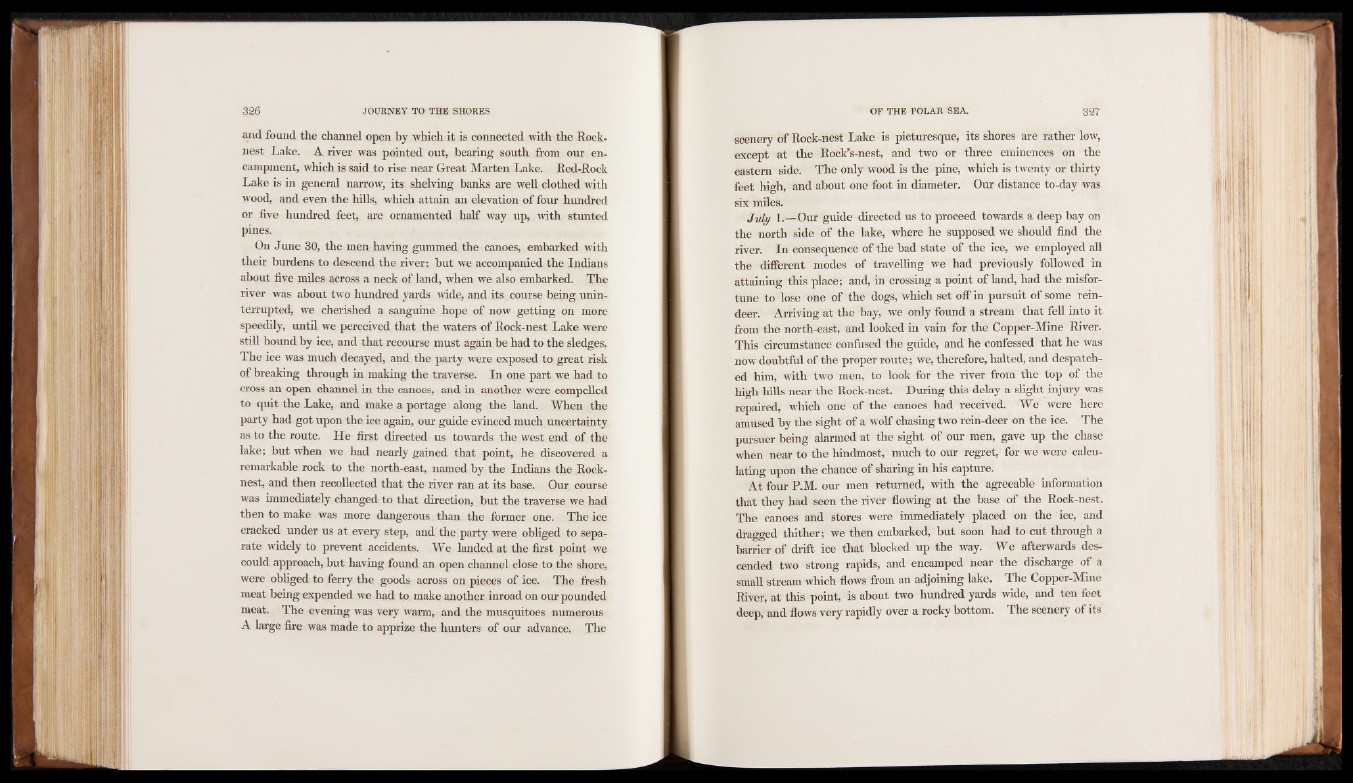
and found the channel open by which it is connected with the Rock-
nest Lake. A river was pointed out, bearing south from our encampment,
which is said to rise near Great Marten Lake. Red-Rock
Lake is in general narrow, its shelving banks are well clothed with
wood, and even the hills, which attain an elevation of four hundred
or five hundred feet, are ornamented half way up, with stunted
pines.
On June 30, the men having gummed the canoes, embarked with
their burdens to descend the river; but we accompanied the Indians
about five miles across a neck of land, when we also embarked. The
river was about two hundred yards wide, and its course being uninterrupted,
we cherished a sanguine hope of now getting on more
speedily, until we perceived that the waters of Rock-nest Lake were
still bound by ice, and that recourse must again be had to the sledges.
The ice was much decayed, and the party were exposed to great risk
of breaking through in making the traverse. In one part we had to
cross an open channel in the canoes, and in another were compelled
to quit the Lake, and make a portage along the land. When the
party had got upon the ice again, our guide evinced much uncertainty
as to the route. He first directed us towards the west end of the
lake; but when we had nearly gained that point, he discovered a
remarkable rock to the north-east, named by the Indians the Rock-
nest, and then recollected that the river ran at its base. Our course
was immediately changed to that direction, but the traverse we had
then to make was more dangerous. than the former one. The ice
cracked under us at every step, and the party were obliged to separate
widely to prevent accidents. We landed at the first point we
could approach, but having found an open channel close to the shore,
were obliged to ferry the goods across on pieces of ice. The fresh
meat being expended we had to make another inroad on our pounded
meat. The evening was very warm, and the musquitoes numerous
A large fire was made to apprize the hunters of our advance, The
scenery of Rock-nest Lake is picturesque, its shores are rather low,
except at the Rock’s-nest, and two or three eminences on the
eastern side. The only wood is the pine, which is twenty or thirty
feet high, and about one foot in diameter. Our distance to-day was
six miles.
July 1.—Our guide directed us to proceed towards a deep bay on
the north side of the lake, where he supposed we should find the
river. In consequence of the bad state of the ice, we employed all
the different modes of travelling we had previously followed in
attaining this place; and, in crossing a point of land, had the misfortune
to lose one of the dogs, which set off in pursuit of some reindeer.
Arriving at the bay, we only found a stream that fell into it
from the north-east, and looked in vain for the Copper-Mine River.
This circumstance confused the guide, and he confessed that he was
now doubtful of the proper route; we, therefore, halted, and despatched
him, with two men, to look for the river from the top of the
high hills near the Rock-nest. During this delay a slight injury was
repaired, which one of the canoes had received. Wi‘ were here
amused by the sight of a wolf chasing two rein-deer on the ice. The
pursuer being alarmed at the sight of our men, gave up the chase
when near to the hindmost, much to our regret, for we were calculating
upon the chance of sharing in his capture.
At four P.M. our men returned, with the agreeable information
that they had seen the river flowing at the base of the Rock-nest.
The canoes and stores were immediately placed on the ice, and
dragged thither; we then embarked, but soon had to cut through a
barrier of drift ice that blocked up the way. We afterwards descended
two strong rapids, and encamped near the discharge of a
small stream which flows from an adjoining lake. The Copper-Mine
River, at this point, is about two hundred yards wide, and ten feet
deep, and flows very rapidly over a rocky bottom. The scenery of its